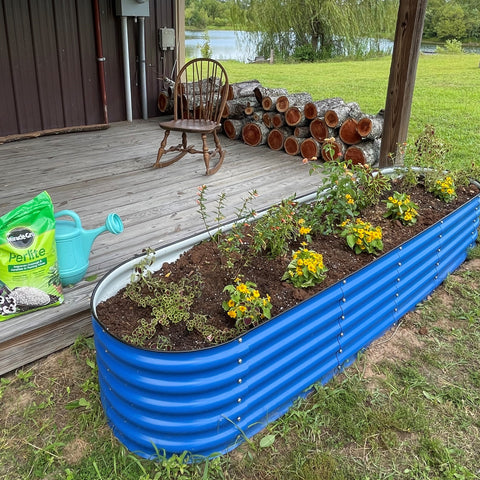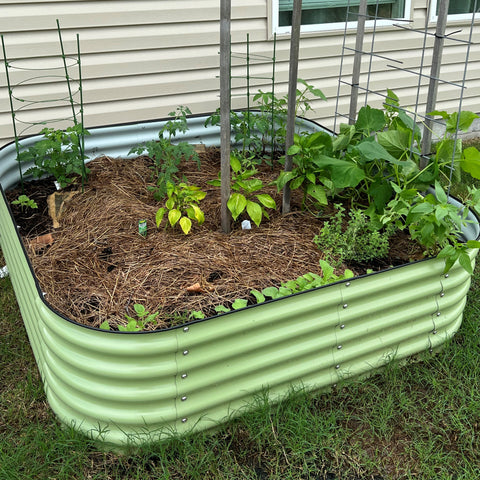Simple Method from Olle Garden Bed For Checking Soil Moisture
Water supports all biological processes and systems of plants. The water content in the garden soil will affect the growth of plants, especially in the hot and dry climate. Dehydration impairs plant health, which is why it is so important to check the soil for obvious signs of drying. The following content also has some reference value for raised garden beds.

Checking soil moisture sounds simple, but there are hard to detect signs that your plant needs to be hydrated immediately. In this guide, we outline the methods for checking soil moisture:
Visual observation
Perhaps the easiest way to check whether your garden soil needs water urgently is to check the ground. If the soil looks dry, light and compact, that means you have to water the soil more.
However, notice that some soil types have a shallow appearance, whether they are wet or not. Our advice is to become familiar with the different soil types and understand the soil types in the garden.
If your garden soil looks muddy, soft or mossy, the ground is flooded. Although mossy soil is a good environment for growth, the risk of root rot is too great for some plants. If this is the case with your garden soil, consider installing an irrigation system to remove excess water from the plants.
Feel
Soil moisture other than visual inspection includes digging the soil with a hand spatula or sharp shovel. You want to go straight into the ground and dig 2 feet deep. Make another piece, about an inch in front of the first piece, and then grasp the piece of soil you just made. Place the soil slice on a piece of white paper or fabric and check the dark area of the soil. If the soil slice is shallow, it is dry; if it is dark, the soil is wet. You can use a ruler to measure the downward extension of the wet layer.
Another way to check the soil by feeling is to get a handful of soil. Squeeze the soil to check moisture. If you squeeze and the soil sticks together, it is moist. However, if the soil breaks up or remains loose when squeezed, the ground requires more water. Now put down the soil and brush off the soil. If your palms look clean, the soil is very dry.
Obtain soil moisture probe
Simply insert the probe into the soil and read the results. It should not take long to check the humidity level. If you use a digital probe, it will take a few seconds. If you are using a traditional scale probe, check that the arrow moves and stops at a specific number on the scale indicator.
Checking a large area of space means that you must use probes to check soil moisture in various areas of the outdoor space. You must spread out in the area to make an overall assessment of the soil moisture level.
To ensure that your soil is in optimal condition, always check for moisture if the soil looks dry or too wet. Install an irrigation system so that your soil always retains moisture. The water content must be kept at level 5, because all kinds of plants can grow and thrive at this level. If the number of probe readings is less than 5, water the soil.
In addition to the soil moisture probe, you can also use a tensiometer and a resistance block to determine the moisture in the soil. These tools are usually used for agricultural applications, but they can also be used in small gardens.
Time domain reflectometry or TDR is also used to check soil moisture, but this method is expensive. However, the results are very accurate. If you use this tool, remember that the sensor requires periodic recalibration. For most growers, these data are also difficult to interpret.

Benefits of checking and monitoring soil moisture
- It is important to check soil moisture because water is the solvent and carrier of nutrients essential for plant growth. Water in soil is so important in agriculture that crop yield depends on available water, not lack of food nutrients.
- Water regulates soil temperature and promotes soil health. It also supports the water needs of billions of microorganisms living in garden soil. Water also contributes to the biological and chemical processes of the soil itself, enabling the soil to support plant and animal life.
- In addition, water itself is a nutrient. In fact, water is one of the main components of plant growth. It is also an important part of photosynthesis, enabling plants to use sunlight to create food.
- Monitoring soil moisture early in the season or growing season to maximize crop yield is critical. For most growers, simple visual observation and hand feeling are enough to check the soil moisture. But for those who grow crops for a living, using farm tools is a better strategy. However, some of these tools are either expensive or require training to apply them correctly.
